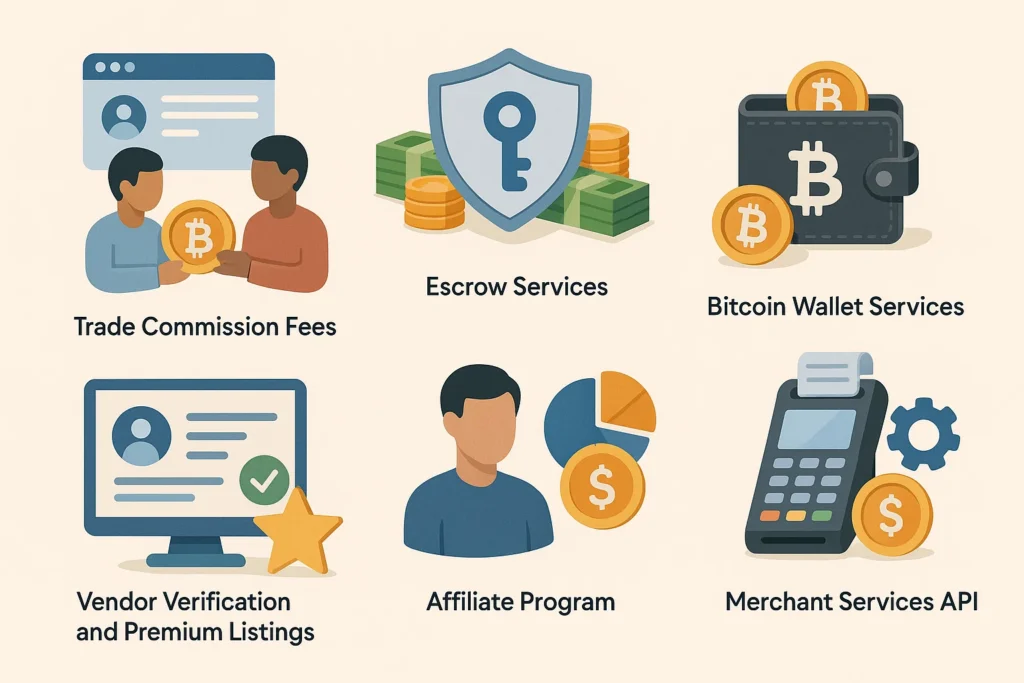Paxful has carved out a niche in the world of crypto trading by doing something radically different — it connects buyers and sellers directly, without acting as a traditional exchange. Launched in 2015, Paxful is a peer-to-peer Bitcoin marketplace that enables users across the globe to buy, sell, and trade crypto using 300+ payment methods, from PayPal to gift cards and bank transfers.
With over 10 million users and billions in traded volume, Paxful has become a lifeline for users in regions where traditional banking is limited or trust in financial institutions is low. But how does a platform that doesn’t “sell” crypto itself generate revenue?
In this blog, we’ll explore the monetization strategy of Paxful, its key revenue streams, and how startups can replicate this proven model with a Paxful clone solution by Miracuves.
How Paxful Makes Money
Paxful’s revenue model is designed around enabling secure crypto trades while monetizing the services that support peer-to-peer transactions. Here are the main income streams:
- Trade Commission Fees – Paxful charges a fee to sellers for each completed trade on the platform.
- Escrow Services – The platform charges indirectly through the escrow system by facilitating trust in each transaction.
- Bitcoin Wallet Services – While creating and maintaining wallets is free, certain transactions (like withdrawals) incur fees.
- Vendor Verification and Premium Listings – Paxful allows vendors to gain visibility through featured placements.
- Affiliate Program – Paxful earns indirectly by growing its user base through revenue-sharing with affiliates.
- Merchant Services API – Businesses integrating Paxful’s payment gateway or API may incur processing fees.
Together, these channels power a self-sustaining ecosystem where Paxful earns by enabling trust, volume, and visibility within its crypto marketplace.

Paxful turned peer-to-peer Bitcoin trading into a global business powered by escrow and transaction fees—explore the Paxful business model to see how it earns revenue.
Detailed Breakdown of Revenue Channels
Trade Commission Fees
Paxful charges sellers a flat 1% fee on every completed transaction. This is the primary source of revenue and incentivizes a large volume of peer-to-peer trades.
- Who Pays? Crypto sellers on the platform.
- Why It Scales? More trades = more revenue, without holding any inventory.
Escrow Services
To ensure safe transactions, Paxful holds crypto in escrow until the buyer confirms payment. While escrow is built-in and free to users, its existence justifies the platform’s commission fee and builds trust — which directly fuels repeat usage and trade volume.
- Who Pays? Indirectly paid through the seller fee structure.
- Why It Scales? It automates trust and keeps transactions flowing securely.
Bitcoin Wallet Services
Paxful offers free wallets for users, but charges apply to specific actions — such as external BTC withdrawals (up to 0.0005 BTC per withdrawal). This creates a steady, small-margin revenue stream.
- Who Pays? Users withdrawing to external wallets.
- Why It Scales? High transaction volume across millions of users.
Vendor Verification and Premium Listings
Vendors can enhance their visibility and credibility by subscribing to premium placements or getting verified badges. These added perks are paid, giving serious traders an edge while contributing to platform revenue.
- Who Pays? Power sellers and vendors.
- Why It Scales? Recurring income tied to reputation and lead generation.
Affiliate Program
Paxful rewards users for bringing in new traders. While affiliates are paid a portion of the fee, Paxful still profits through the overall increased trading activity and lifetime user value.
- Who Pays? Paxful shares a portion of its commission; costs are tied to performance.
- Why It Scales? Zero customer acquisition cost until value is delivered.
Merchant Services API
Businesses that integrate Paxful’s crypto checkout or invoicing services may incur processing fees. This B2B solution offers a separate monetization stream through external partnerships.
- Who Pays? Businesses using Paxful as a crypto payment processor.
- Why It Scales? Grows beyond the P2P space and into merchant services.
Paxful supports hundreds of payment methods for global accessibility—check out the Paxful app features that make it truly flexible.
Why This Revenue Model Works in 2025
Paxful’s peer-to-peer model continues to thrive in 2025 due to several key market dynamics, technology trends, and shifts in user behavior.
Global Push for Financial Inclusion
Millions of users in Africa, Asia, and Latin America still lack access to traditional banking. Paxful’s model fills that gap by allowing users to trade crypto using local payment methods, creating revenue in emerging markets that are often ignored by mainstream exchanges.
Trustless Transactions with Escrow
With crypto scams still rampant, Paxful’s escrow system remains a critical differentiator. It builds confidence among users, enabling higher transaction volumes — which directly fuels the platform’s 1% seller commission stream.
Growing Use of Alternative Payment Methods
In 2025, users expect more than just bank transfers. Paxful supports 300+ payment methods including PayPal, CashApp, Western Union, gift cards, and more. This flexibility draws in users globally and fuels more trades — which Paxful monetizes through seller fees.
Decentralized Mindset in Users
As more users lean toward decentralized platforms, Paxful’s non-custodial nature (not holding user funds) appeals to a wide audience. Its model benefits from higher engagement without the liability of asset management.
Scalable Micro-Fee Model
Paxful’s small commissions and service charges are low enough to encourage usage, yet large enough to scale profitably across millions of trades. Combined with cost-efficient affiliate growth, this creates a compounding effect.
Paxful grew by turning security and accessibility into marketing assets—discover the Paxful app marketing strategy that built global trust.
Can Startups Replicate Paxful’s Revenue Model?
Yes — but it’s not as simple as launching a crypto exchange.
To replicate Paxful’s revenue model, a startup needs more than just a wallet and trading interface. You’ll need to build escrow functionality, user verification, multi-payment method integrations, dispute management systems, affiliate tracking, and secure wallet operations — all while ensuring compliance and scalability.
That’s where Miracuves makes a real difference.
With our ready-made Paxful Clone, you get a full-featured peer-to-peer crypto trading platform that mirrors Paxful’s monetization structure from day one. Our solution includes:
- Seller commission configuration
- Secure escrow engine
- Multi-currency wallet with withdrawal fee controls
- Payment method flexibility (100+ options)
- Vendor rating, verification, and listing boost tools
- Built-in affiliate referral tracking
- KYC/AML ready modules for compliance
You don’t have to build the foundation from scratch or spend years developing trust-based mechanisms. Miracuves offers a faster, customizable, and affordable launch path — with revenue channels already embedded and ready to activate.
The Paxful Clone by Miracuves is priced at $2,899, offering a white-label P2P crypto exchange solution that supports secure escrow and multiple payment methods — ready to go live within 3 days with app publishing support.
Launching your own crypto exchange gets easier when you start with the best Paxful clone scripts in 2025, dive deeper with our developer insights on building a Paxful-like app, and plan ahead using the Paxful clone development cost breakdown from MVP to full-scale.
Conclusion
Paxful’s peer-to-peer marketplace has disrupted the traditional crypto exchange model by focusing on decentralization, trust, and user freedom. It doesn’t sell Bitcoin — it empowers users to trade it directly. And in doing so, it earns from commissions, wallet services, vendor tools, and affiliate-powered growth.
This lean yet powerful revenue model is well-suited for the evolving financial landscape of 2025 — where inclusion, flexibility, and user autonomy are key.
The good news? You don’t need to reinvent this system. With Miracuves’ Paxful Clone, you can launch a ready-to-monetize P2P crypto platform — equipped with escrow, commissions, and scalable revenue features from the start.
FAQs
How does Paxful generate revenue?
Paxful earns revenue primarily through a 1% commission on each trade from the seller, along with service fees for wallet withdrawals, vendor promotions, and merchant integrations.
Is Paxful profitable in 2025?
While Paxful does not publicly disclose full profit figures, its scalable fee-based model and growing user base across emerging markets contribute to steady, sustainable profitability.
What are the main income sources for Paxful?
Its main revenue streams include trade commissions, wallet withdrawal fees, premium vendor listings, merchant service fees, and affiliate-driven user acquisition.
Can startups use the same revenue model as Paxful?
Yes, startups can replicate Paxful’s model using a peer-to-peer platform architecture. However, building it from scratch is complex — using a Paxful clone from Miracuves greatly reduces time, cost, and effort.
Does Miracuves offer a Paxful clone with monetization features?
Absolutely. Miracuves’ Paxful clone includes configurable commissions, escrow, payment integrations, wallet fee controls, and all the monetization mechanisms required for a P2P crypto marketplace.








